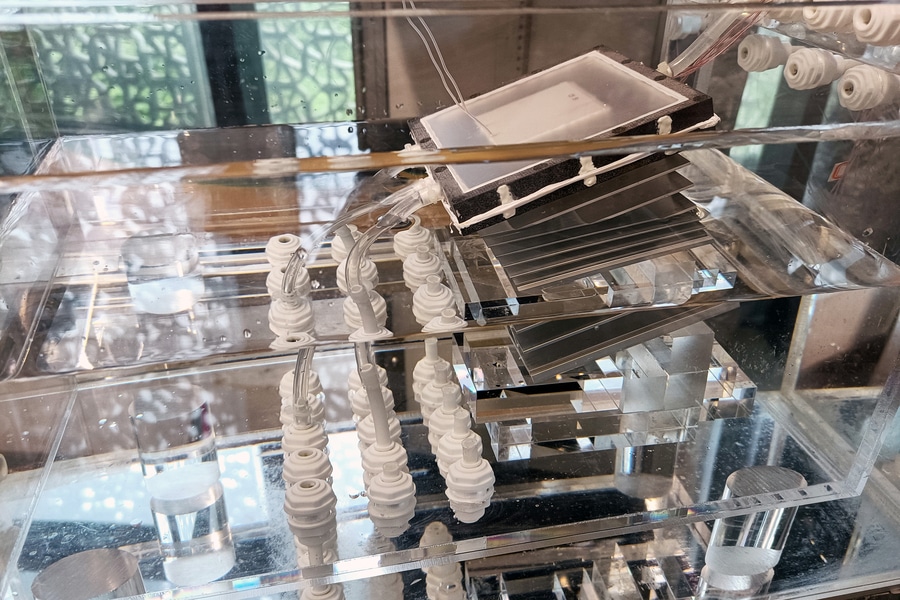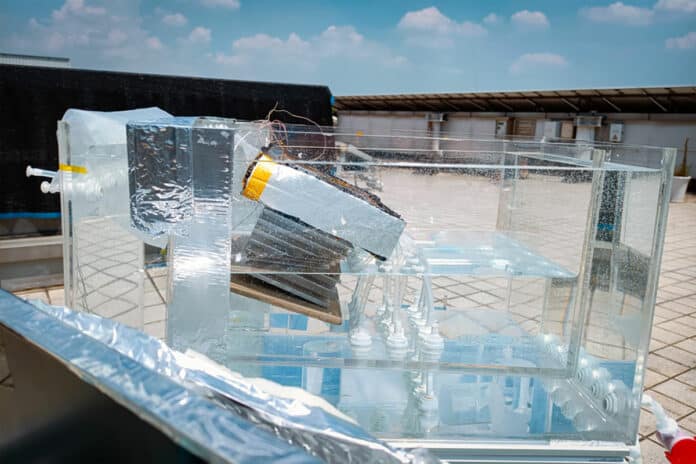Recent advances in multistage solar distillation technology have shown great promise in providing a sustainable supply of freshwater. However, the accumulation of salt has led to a significant reduction in the system’s performance, making it challenging to maintain long-term reliability and efficiently treat hypersaline discharge.
Now, engineers from MIT and China have collaborated to create a solar-powered desalination system that can convert saltwater into drinking water at a higher volume and lower cost.
The configuration of the device allows water to circulate in swirling eddies that look like small whirlpools that function similarly to the ocean’s much larger thermohaline circulation. This circulation, combined with the sun’s heat, drives water to evaporate, leaving salt behind.
The resulting water vapor can then be condensed and collected as pure, drinkable water. In the meantime, the leftover salt continues to circulate through and out of the device rather than accumulating and clogging the system.
“When seawater is exposed to air, sunlight drives water to evaporate. Once water leaves the surface, salt remains. And the higher the salt concentration, the denser the liquid, and this heavier water wants to flow downward,” explains Lenan Zhang, a research scientist in MIT’s Device Research Laboratory. “By mimicking this kilometer-wide phenomenon in a small box, we can take advantage of this feature to reject salt.”
The team’s new design is a combination of their two previous concepts: a multistage system of evaporators and condensers that is also configured to boost the circulation of water – and salt – within each stage. Researchers used a thin box topped with a dark material that efficiently absorbs the heat of the sun. Inside, the box is separated into a top and bottom section.
Water can pass through the top half, where the ceiling is lined with an evaporator layer that utilizes the sun’s heat to warm up and evaporate any water in direct contact. The water vapor is then directed to the bottom half of the box, where a condensing layer air-cools the vapor into a salt-free, drinkable liquid.

Researchers set the entire box at a tilt within a larger, empty container, then connected a tube from the top half of the box down through the bottom of the vessel and floated the vessel in saltwater.
The water can naturally push up through the tube and into the box. Due to the tilt of the box and the thermal energy from sunlight, the water inside swirls around, creating small eddies. These eddies help to bring water in contact with the upper evaporating layer while keeping salt circulating rather than settling and clogging.
The new system is currently undergoing testing and shows promising results. It has a higher water-production rate and a higher salt-rejection rate compared to other passive solar desalination concepts that are being tested.
According to the researchers, a small suitcase-sized version of the system could generate 4 to 6 liters of drinking water per hour and operate for several years before needing any replacement parts. Given this extended lifetime and the fact that the system is entirely passive, requiring no electricity to run, the team estimates that the overall cost of running the system would be cheaper than what it costs to produce tap water.
The team envisions a scaled-up device that could passively produce enough drinking water to meet the daily needs of a small family. The system could also supply off-grid, coastal communities where seawater is easily accessible.
